How Do You Keep A Polar Bear From Charging?
Insist that it pay cash! Ah ha ha ha ha, that's a good one.
No, really, after yesterday's polar bear sighting I am writing a journal completely dedicated to polar bears.
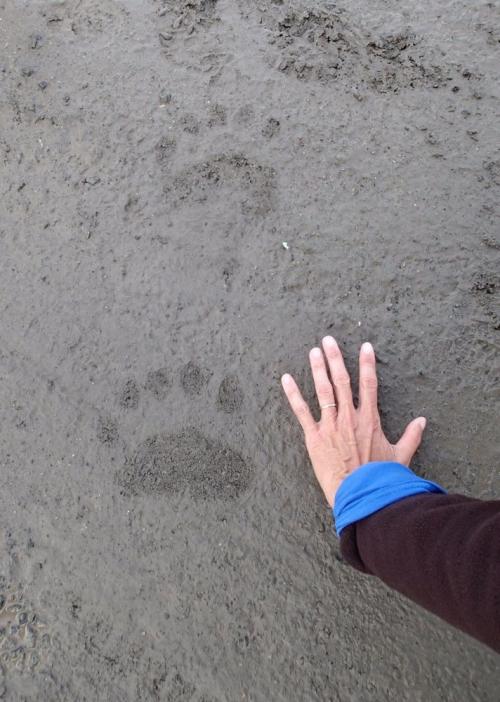 My hand next to a polar bear print!
My hand next to a polar bear print!
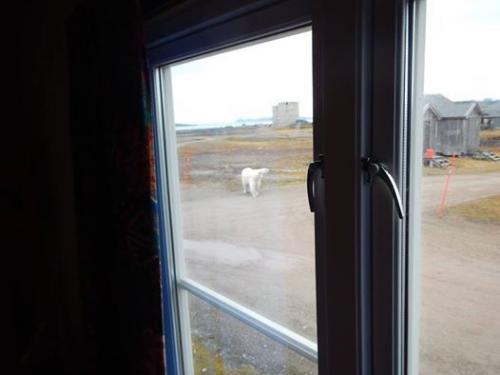 Polar bear outside the dorm! Photo by Dr. Julie Brigham-Grette.
Polar bear outside the dorm! Photo by Dr. Julie Brigham-Grette.
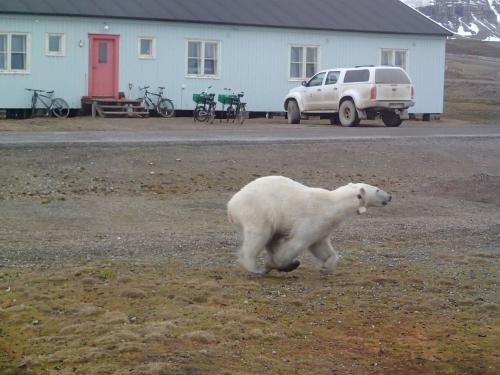 She needs a better name than N23882. Suggestions?
She needs a better name than N23882. Suggestions?
If you are interested in more information on polar bears, Polar Bears International has a wonderful website. You can track a collared polar bear at WWF's (World Wildlife Fund) Polar Bear Tracker. You might have noticed from the pictures that yesterday's polar bear was collared. Based on the tracker at WWF, we think that maybe this was the bear designated N23882. If so, she is a 12 year old female weighing 408 pounds. She had cubs 2 years ago and they have already left her and gone on their own. I think she needs a better name than N23882. Any suggestions?
Polar bear research is fascinating. They are collared to understand their behavior, assess their health and understand how climate change and other threats are impacting the population. You can watch scientists from the Norwegian Polar Institute assess a polar bear's health in this short video:
Take A Closer Look
Ellyssa asks, "What is the average amount of cubs a female polar bear can have?"
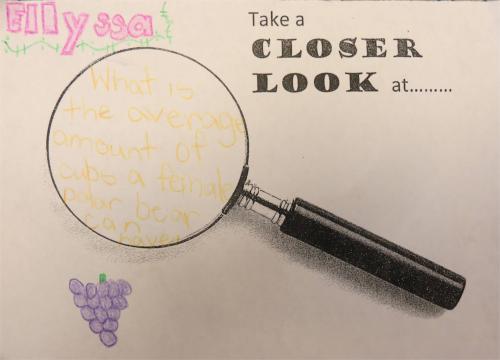 What is the average amount of cubs a polar bear can have?
What is the average amount of cubs a polar bear can have?
Polar bears usually have twins. They can have a single cub or triplets too. A polar bear usually has five litters in its life.
Kitty from the Girl Scouts asks, "How old do polar bears live up to?"
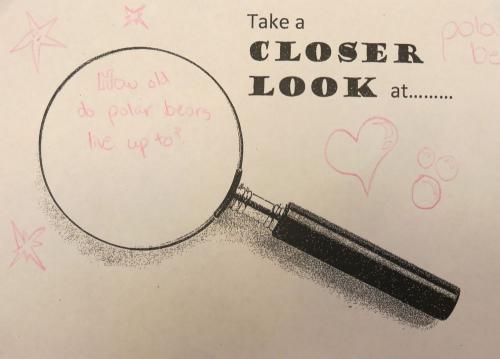 How old do polar bears live up to?
How old do polar bears live up to?
Polar bears live to be 15 to 18 years old. In a zoo they can double their life span. What do you think is better for the polar bear? To live a shorter life in the wild or longer in a zoo?
Maya V. from Avocado Elementary School asks, "What do you do if you run into a polar bear and the polar bear is coming closer?"
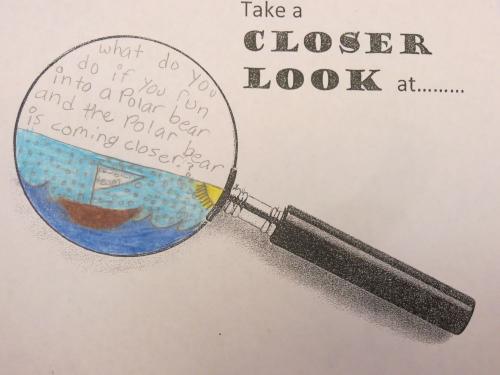 What do you do if you run into a polar bear and the polar bear is coming closer?
What do you do if you run into a polar bear and the polar bear is coming closer?
This is what we learned in our polar bear defense class:
If a polar bear starts to approach, you should keep it in view and make noise. Shouting, clapping your hands or revving your engine are all good ways to make noise.
If this doesn't work, shoot a flare on the ground between you and the bear. Repeat if it doesn't have any effect.
If the polar bear starts "hunting" you, quickly retreat and go into a cabin or take refuge until the danger has passed.
If none of this works, shoot the bear with a large-calibre rifle. Aim at the shoulders or chest. Shoot until the bear lies still.
My wonderful student, Olivia B. from Los Coches Creek Middle School (yay!) asks, "What if the polar bear attacked you from behind and you couldn't get your gun fast enough?"
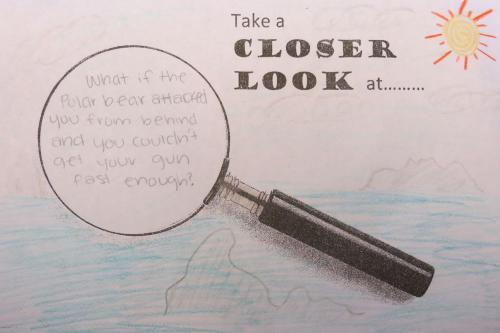 What if the polar bear attacked you from behind and you couldn't get your gun fast enough?
What if the polar bear attacked you from behind and you couldn't get your gun fast enough?
Well Olivia, if a polar bear attacked me from behind and I didn't have time to get my gun I would most likely die. Good thing I already had you and your sisters as students. But, I don't think that will happen.
Another favorite student from Los Coches Creek Middle School (yay!), Julia C. asks, Are polar bears mean? Does their fur change color in the different seasons?
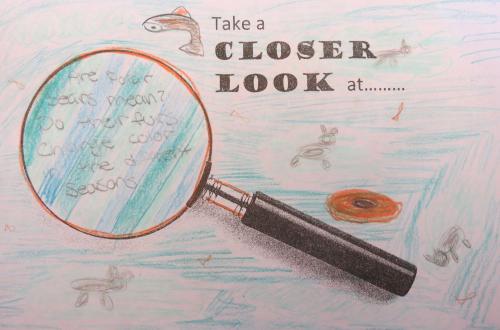 Are polar bears mean? Does their fur change color in the different seasons?
Are polar bears mean? Does their fur change color in the different seasons?
When you ask if polar bears are mean, you are being anthropomorphic, which means attributing human characteristics to animals or objects. (Maybe you talked about this with Mr. Roemmich?) Polar bears aren't mean, they are just being polar bears. To compare we can ask if humans are mean because we eat hamburger. Some might say yes, but generally, that is just what humans do. We eat meat and most of us aren't mean. But from the perspective of the cow, they might think we are mean. But now I am anthropomorphizing the cow. Polar bears aren't mean, but they've got to eat and hunting and killing is how they get their food. In the spring, polar bears molt (shed and replace their fur) and after this their fur is especially clean and white. Prior to the molt they can appear yellowish from consuming oils in the seal that they eat. And guess what? A polar bear's skin is black! This helps with heat absorption. The hairs are hollow and fill with water that is warmed by the body, keeping a warm layer next to the bear. This works like the wet suits we wear.
Finally, Melanie R. from Brooklyn Prospect Charter School asks, "What are the polar bear's lifestyle and habits?"
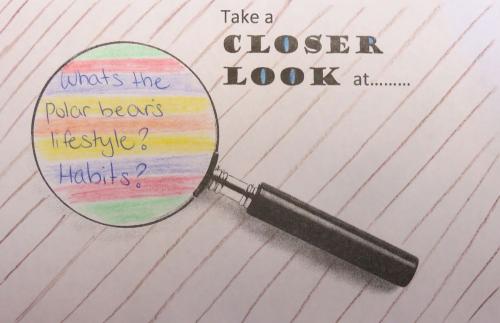 What are the polar bear's lifestyle and habits?
What are the polar bear's lifestyle and habits?
Polar bears are classified as marine mammals (like walruses and seas) because their habitat is the sea. They swim between ice floes where they hunt their favorite meal, which is seal. Seals make holes in the ice called aglus which they use to come up and breathe. A polar bear will wait by an aglus for a seal to surface. To do this they must be smart and patient. Polar bears have cubs in early winter in a snow den that they dig on land. They emerge three months later. Polar bears do not hibernate. With the exception of pregnant females, polar bears remain active throughout the year. Even pregnant polar bears do not hibernate. Their bodies stay warm in order to meet the demands of pregnancy, birth and nursing. Polar bear live in Canada, Alaska, Greenland, Russia and Svalbard.
I think the most important thing to know about polar bear is that they are listed as a threatened species under the Endangered Species Act. Sea ice loss from global warming is the single biggest threat to polar bears. Polar bears depend on their sea ice habitat to hunt. If they can't hunt seal, they starve. So what can we do? The Earth is warming because humans are increasing the amount of carbon dioxide in the atmosphere. Carbon dioxide does not allow as much heat to escape from the planet. It acts like a blanket. Humans increase carbon dioxide in the atmosphere by burning fossil fuels- gas, coal, natural gas, oil, etc. By burning less fossil fuel, we will decrease the carbon dioxide we add to the atmosphere, contribute less to global warming, slow the melting of ice and protect the polar bear habitat. Here is what you can do:
Talk about climate change with your friends and family
Walk, ride a bike and take public transportation. Drive fuel efficient cars.
Use less energy at work, school and home. Consider installing solar panels
Reduce, reuse, recycle


Comments